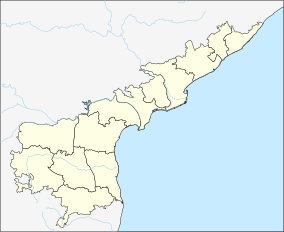Coringa Wildlife Sanctuary
| Corinnga Wildlife Sanctuary (Of Chollangi) | |
|---|---|
|
IUCN category IV (habitat/species management area)
|
|

The Godavari Estuary in Coringa Wildlife Sanctuary
|
|
|
Location of Coringa Wildlife Sanctuary in Andhra Pradesh, India
|
|
| Location | Andhra Pradesh, India |
| Nearest city | Kakinada |
| Coordinates | 16°49′53″N 82°20′12″E / 16.83139°N 82.33667°ECoordinates: 16°49′53″N 82°20′12″E / 16.83139°N 82.33667°E |
| Area | 235.7 km2 (58,200 acres) |
| Established | July 5, 1978 |
| Governing body | Andhra Pradesh Forest Department |
Coringa Wildlife Sanctuary is a wildlife sanctuary and estuary situated in Andhra Pradesh, India. It is the second largest stretch of mangrove forests in India with 24 mangrove tree species and more than 120 bird species. It is home to the critically endangered white-backed vulture and the long billed vulture.
Coringa Wildlife Sanctuary is 18 km from the port city of Kakinada, on the Kakinada-Yanam state highway in Chollangi Village, nestling on the deltaic branches of Gouthami and Godavari Rivers at Kakinada Bay.
It is located between 16°-30' to 17°-00' N latitudes and 82°-14' to 82°-23'E longitudes.
The sanctuary is a part of the Godavari estuary and has extensive mangrove and dry deciduous tropical forest.
About half of the area is the backwater, which includes a sand pit of 18 km length. The rivers Coringa and Gaderu and their deltaic branches intersect the region, along with other water channels. This forms about 335.7 square km of marsh vegetation.
The average temperature of the region is 17 °C to 40 °C.
Average Rainfall is greater than 1,000 mm.
The Sanctuary in the estuary of river godavari has rich mangrove vegetation. There are thirty five species of plants belonging to twenty four families. The plant species that are commonly found are:
Avicennia officinalis, Avicennia marina, Avicennia alba, Excoecaria agallocha, Rhizophora mucronata, Ceriops decandra, Bruguiera gymnorrhiza, Lumnitzera recemosa, Sonneratia apetala, Rhizophora conjugata, Aegiceras corniculatum, Thespesia populneoides and Hibiscus tiliaceus.
...
Wikipedia

